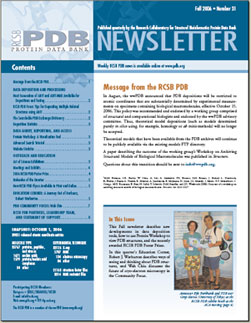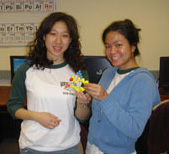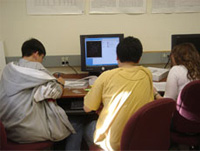2006 PDB News
Contents:
Read the latest PDB news. Earlier news is available and is archived in the RCSB PDB newsletters.
26-December-2006
Best wishes to the community for a happy holiday season and a wonderful new year!
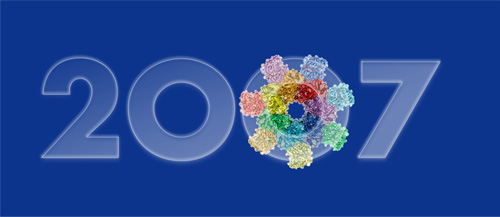
19-December-2006

RCSB PDB Poster Prize Awarded at AsCA
Thanks to everyone who participated in the recent competition for best student poster related to macromolecular crystallography at the Joint Conference of the Asian Crystallographic Association and the Crystallographic Society of Japan (AsCA; November 20-23 in Tsukuba, Japan). The RCSB PDB Poster Prize went to:
Structural studies on the SUF proteins involved in the biogenesis of iron-sulfur clusters
Norika Sumi (1), Kei Wada (1), Shintaro Kitaoka (1), Kei Suzuki (1), Yuko Hasegawa (1), Yoshiko Minami (2), Yasuhiro Takahashi (1), and Keiichi Fukuyama (1)
(1) Department of Biology, Graduate School of Science, Osaka University, Toyonaka, Osaka 560-0043 Japan
(2) Department of Biochemistry, Faculty of Science, Okayama University of Science, Okayama 700-0005 Japan
Many thanks to our judges and organizer.
Judges: Anders Liljas (Chair; Lund University), K. Byrappa (University of Mysore), Mitchell Guss (University of Sydney), Chwan-Deng Hsiao (Academia Sinica), and Genji Kurisu (University of Tokyo)
Organizer: Soichi Wakatsuki (Institute of Materials Structure Science, KEK, Japan)
12-December-2006
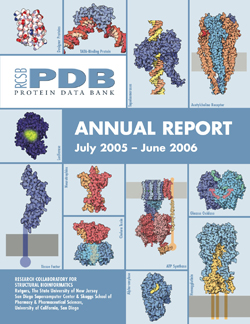
RCSB PDB's 2006 Annual Report Now Available
The RCSB Protein Data Bank's Annual Report is currently being distributed. Covering the period of July 1, 2005 - June 30, 2006, this report documents the recently released database and website.
This Annual Report provides background information about the RCSB PDB resource and describes current progress and accomplishments. Available online as a PDF, this snapshot also explores the RCSB PDB's different activities in data deposition, structural genomics, and education.
The cover highlights the structures featured in the Molecule of the Month series during the report period. Each installment introduces readers to the structure and function of a particular molecule, and discusses the relevance of the molecule to human health and welfare. Written and illustrated by David S. Goodsell (The Scripps Research Institute), the series is a great place for users of all levels to start exploring the RCSB PDB resource. This cover, along with information about the proteins, is also available as a downloadable flyer.
The report is distributed to the diverse community of PDB users in academia, industry, and education. If you would like a printed copy of this report, please send your postal address to info@rcsb.org.
05-December-2006
wwPDB Paper Published
A paper describing the wwPDB – background, data deposition and access information, data uniformity efforts, and more – has been published:
The worldwide Protein Data Bank (wwPDB): ensuring a single, uniform
archive of PDB data
Helen Berman; Kim Henrick; Haruki Nakamura; John L. Markley
Nucleic Acids Research 2006; doi: 10.1093/nar/gkl971
28-November-2006
Feedback Survey: RCSB PDB Website and Your Browser
The RCSB PDB is working to resolve any browser issues dealing with the latest release of this website. Please let us know at info@rcsb.org if you have been experiencing any difficulties when accessing www.pdb.org, including:
- The nature of the problem: what were you doing when it failed? What was the nature of the failure?
- Browser type and version
- Operating system
- Any security or plug-in issues
This information will help us to better support the many combinations of hardware, operating systems, security requirements, browser types, and plug-ins.
21-November-2006
RCSB PDB Focus: Depositing New Chemical Components (Ligands)
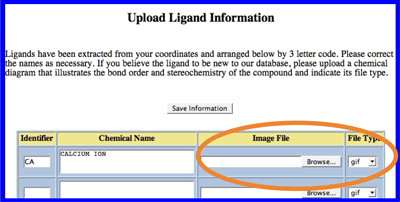
To deposit new ligands, please check Ligand Depot to see if the ligand, drug, ion, non-standard residue, modified residue, group, etc. is present in our chemical component dictionary.
If the ligand is present, please make sure that the 3 letter code for the ligand in your file matches the one used in the chemical component dictionary.
If the ligand is not present in the dictionary, users can now upload a 2-D figure of the structure as part of the ADIT deposition process in PostScript, TIFF, or GIF formats. From the left-hand categories menu, scroll down and select the "Upload Supplemental Information: Ligand Information" to provide this information. Although the 3 letter code used for the ligand has no specific significance, you may check Ligand Depot and select a code for your ligand that has not been taken, otherwise, one will be selected for you.
Questions about ligands should be sent to deposit@deposit.rcsb.org.
RCSB PDB Focus: External Links
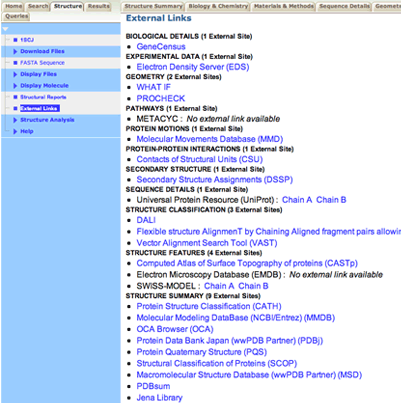
Structure Summary pages for all structures in the PDB now offer a set of external links. Accessible from the left menu, these links provide further information about the structure under study, such as biochemical pathway information, stereochemistry and ligand binding data.
14-November-2006
Annotation at the Research Collaboratory for Structural Bioinformatics Protein Data Bank
The question "So, what does an 'annotator' do?" has been answered with the article:
A Biocurator Perspective: Annotation at the Research Collaboratory for Structural Bioinformatics Protein Data Bank
Kyle Burkhardt, Bohdan Schneider, Jeramia Ory
(2006) PLoS Comput Biol 2(10): e99
The typical day of an annotator and the challenges facing PDB curators are described. This issue of PLoS also contains an editorial recognizing the efforts of biocurators worldwide and a description of the curation process in use at the Immune Epitope Database and Analysis Resource (IEDB).
The RCSB PDB is looking for Biochemical Information & Annotation Specialists to curate and standardize macromolecular structures for distribution in the PDB archive. As described in this article, the annotation specialist communicates daily with members of the deposition community, and annotates, releases, and updates entries in the PDB archive. BLAST, PubMed, and other tools are used for the annotation process performed on a linux box.
A background in biological chemistry (PhD, MS, BS or BA) is required. Experience with linux computer systems, biological databases, crystallography, and/or NMR spectroscopy is a strong advantage. The successful candidate should be self-motivated, pay close attention to detail, possess strong written and oral communication skills, and meet deadlines. The position is located in Piscataway, NJ.
This position offers the opportunity to participate in an exciting project with significant impact on the scientific community.
Please send resumes to Dr. Helen M. Berman at pdbjobs@rcsb.rutgers.edu.
07-November-2006
Searching for Sequence Variants
Protein structure sequences are assigned UniProt/SwissProt IDs(UNP/SWS). The new Sequence Variants/Non-variants RCSB PDB feature lets users retrieve all structures with a particular SWS/UNP ID, grouped by the presence or absence of sequence variations (variants or non-variants). Searches for variants will provide structures with post-translational modifications, whereas searching for non-variants will provide occurrences of structures that have at least one identical polypeptide chain.
This query can be run using the Advanced Search option.
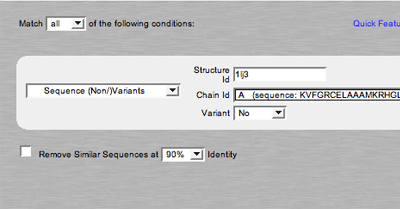
The Advanced Search form for Sequence Variants
- Click on the 'Search' tab on the left-hand menu, and expand the 'Search Database' menu option.
- Click on 'Search Database' >> 'Advanced Search'
- Select 'Choose a Query Type' >> 'Sequence Features' >> 'Sequence (Non/)Variants'
- Enter a structure ID
- Select the desired chain form the pull-down menu
- Select 'No' to retrieve all structures whose sequences do not vary from the reference sequence due to point mutations/insertions/deletions.
- Variant = 'Yes' retrieves all structures whose sequences vary from the reference UNP/SWS sequence due to point mutations/insertions/deletions.

Structure Summary pages offer options for viewing Sequence Variants from the "Structure Analysis" option
For example, using 1LJ3 chain A, 'variant = No' will pull up structures of lysozyme with no sequence variations.
Variants and non-variants can also be retrieved from the Structure Summary page for any structure having such variants with the same UNP/SWS ID. From the lefthand menu, select Structure Analysis-> Sequence Variants. The resulting page displays the pairwise alignment of the structure sequence and the UNP/SWS sequence for each structure.

Variations are color coded in the alignment display
RCSB PDB Newsletter Fall 2006
The latest RCSB PDB Newsletter has been published in HTML and PDF formats.
This newsletter describes new developments in data deposition tools, how to use Protein Workshop to view PDB structures, and the recently added RCSB PDB Poster Prizes.
In this quarter's Education Corner, Robert J. Warburton describes ways of seeing and thinking about PDB structures, and Wah Chiu discusses the future of cryo-electron microscopy in the Community Focus.
If you would like to receive a printed version of the RCSB PDB quarterly newsletter, please send your postal address to info@rcsb.org.
Subscription information for the plain text electronic version is also available.
31-October-2006
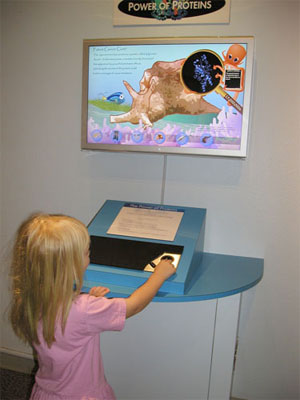
PDB Structures on Exhibit at the Birch Aquarium
The Sea of Genes exhibit at the Birch Aquarium (La Jolla, CA) helps to unravel the genetic secrets of life in the ocean through interactive displays that highlight the exciting discoveries of Scripps researchers.
One feature of this exhibition is an interactive kiosk that invites the user to display information about specific proteins found in marine organisms — and in the PDB. A few of these proteins are also described in a flyer about the exhibit.
This kiosk is the result of a collaboration between the RCSB PDB and the Birch Aquarium (Scripps Institution of Oceanography at University of California, San Diego). The Sea of Genes exhibit will be on display until Spring 2007.
24-October-2006

The ADIT help example for
biological assembly details
PDB Focus: The ADIT Help System
The deposition tool ADIT (at RCSB or PDBj) includes examples and definitions provided in the PDB Exchange Dictionary as guides for users depositing their structures.
An explanation for each piece of information requested by ADIT can be obtained by selecting the Help button located next to the named data item. This information will appear in the bottom frame. Pressing the Help button in the top frame will display these instructions.
Examples for these items can be obtained by selecting the Example button within the table. This information will appear in the bottom frame
At any time during deposition, you may view the current state of the entire entry by pressing the PREVIEW ENTRY button.
Questions about ADIT may be sent to deposit@deposit.rcsb.org.
17-October-2006

SCOP Browser

SCOP and CATH data on the Structure Summary page.
Each annotation is a link to a set of PDB structures.
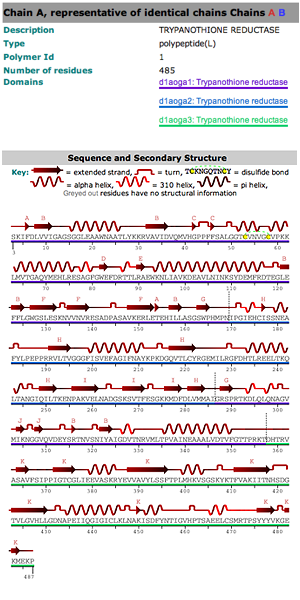
Sequence Details page

Display options on the Sequence Details page
RCSB PDB Focus: Exploring Domains in Protein Structure
Domains can be thought of as the smallest structural units from which proteins are assembled that retain properties of the whole protein, such as a hydrophobic core. In certain cases, domains can also function independently from the rest of the structure. Any given protein structure is comprised of one or more domains from which the overall properties of the protein are derived. Analyzing a protein structure from the point of view of its composite domains is an important, yet not fully solved problem.
The RCSB PDB offers various ways of exploring domains in protein structures:
PDOMAINS (http://pdomains.rcsb.org/pdomains/)1 is a resource centered around the definition and assignment of structural domains in proteins. It offers analysis of existing approaches to domain definition and provides a benchmark dataset to evaluate and cross-compare automatic domain assignment methods.
The Browse Database option of the 'Search' tab on the left-hand menu offers a tool to explore the hierarchically organized and curated domain definitions produced by SCOP and CATH.
Structure Summary pages for individual structures provide links to sets of all structures containing domains similarly categorized by SCOP and CATH.
Sequence Details pages for each structure illustrate domains aligned with sequence and secondary structure. The colored domain definition links in the SCOP Domains section coincide with the colored bars underneath the sequence to indicate the location of the domains. Boundaries between domains are highlighted further with vertical dashed lines.
The user can choose domain definitions according to either SCOP or CATH and the programs DomainParser and PDP.
Questions about these features should be sent to info@rcsb.org.
1Holland TA, Veretnik S, Shindyalov IN, Bourne PE. Partitioning protein structures into domains: why is it so difficult? J Mol Biol. 2006 Aug 18;361(3):562-90.
10-October-2006
DOIs Available for Released Entries in the PDB Archive
Structures released by the wwPDB into the PDB Archive are now being assigned a Document Object Identifier (DOI). The DOI System is used to identify content objects (such as journal articles, books, and figures) in the digital environment.
The DOIs for PDB structures all have the same format – 10.2210/pdbXXXX/pdb – where XXXX should be replaced with the desired PDB ID. For example, the DOI for PDB entry 4HHB is "10.2210/pdb4hhb/pdb". This links directly to the entry in the PDB file format on the FTP server.
The DOI can be used as part of a URL to obtain this data file (http://dx.doi.org/10.2210/pdb4hhb/pdb), or can be entered in a DOI resolver (such as http://www.crossref.org/) to automatically link to pdb4hhb.ent.Z on the main PDB ftp archive (ftp://ftp.rcsb.org).
DOIs are automatically registered by the wwPDB when entries are released after the weekly update. They will not be available before a structure's release. Along with the ftp location, the DOIs for PDB entries also include the entry title, the authors, and the deposition date.
Theoretical Model Depositions to the PDB Archive No Longer Accepted after October 15
Effective October 15, 2006, PDB depositions will be restricted to atomic coordinates that are substantially determined by experimental measurements on specimens containing biological macromolecules. This policy was recommended and endorsed by a working group comprised of structural and computational biologists and endorsed by the wwPDB advisory committee. Thus, theoretical model depositions (such as models determined purely in silico using, for example, homology or ab initio methods) will no longer be accepted.
Theoretical models that have been previously released or that will be released from now until October 15, 2006 will continue to be publicly available via the existing models archive at ftp://ftp.rcsb.org/pub/pdb/data/structures/models/current/.
A summary of the implementation plan for the phasing out of theoretical models is available in HTML and PDF formats. A paper describing the outcome of the Workshop on Archiving Structural Models of Biological Macromolecules was published in Structure1.
Questions about this transition should be sent to info@wwpdb.org.
1. H.M. Berman, S.K. Burley, W. Chiu, A. Sali, A. Adzhubei, P.E. Bourne, S.H. Bryant, J. Roland L. Dunbrack, K. Fidelis, J. Frank, A. Godzik, K. Henrick, A. Joachimiak, B. Heymann, D. Jones, J.L. Markley, J. Moult, G.T. Montelione, C. Orengo, M.G. Rossmann, B. Rost, H. Saibil, T. Schwede, D.M. Standley, and J.D. Westbrook (2006) Outcome of a workshop on archiving structural models of biological macromolecules. Structure. 14: 1211-1217.
03-October-2006
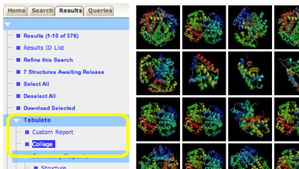
Query results can be organized in an image gallery
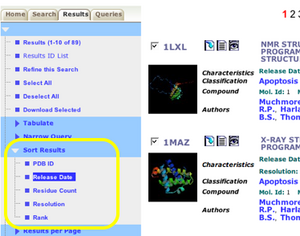
A search results list sorted by Release Date

Citation report for a search results set.
PDB Focus: Sorting Search Results and Tabular Reports
The RCSB PDB offers many ways of looking at the information contained in the database. After searching for a set of structures, users can explore individual structures or examine the whole set by creating reports.
Following a search that produces multiple entries, the results set can be sorted by choosing 'Sort Results' from the menu on the left hand side of the page. Sorting options include: PDB ID, Release Date, Residue Count, Resolution and Rank. An Advanced Search by sequence (Advanced Search>>Sequence Features>>Sequence (Blast/Fasta)) allows the user to sort results by PDB ID, formula weight and E value.
Another option for viewing multiple structure results is available from the left menu's "Tabulate" button. It allows the user to create tables of various structural and experimental properties that can be downloaded as CSV files.
These tables can be sorted by clicking on the column headers. Clicking again reverses the sort order.
The "Custom Report" option lets the user select which columns will be included in the report. "Collage" will tile the thumbnails of all of the molecular images.
Default reports about structure, sequence, ligands, primary citation, and biological details are available from the Summary Reports option. Experimental reports can also be created for X-ray (crystallization, data collection, refinement, refinement parameters, unit cell) and NMR (representative model, spectrometer, sample conditions, software, refinement, and ensemble) structures.
Questions about these features should be sent to info@rcsb.org.
MLSP Forming a Focus Group to Testing Cell Phone Access to PDB Data
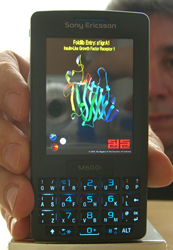
The Mobile Life Sciences Platform (MLSP) initiative seeks to enable users to access complex life sciences information using a smartphone. The MLSP initiative is currently seeking researchers who are interested in being part of the development process. These focus group members would receive the latest software updates for their Windows Mobile smartphone device, report bugs, and provide opinions on the application design and function.
The first MLSP smartphone application will provide access to protein structures and other data currently available from the RCSB PDB website, and allow users to store data on their smartphone.
If you have access to a Windows Mobile 5.0 smartphone, use the RCSB PDB regularly, and would be available for periodic feedback sessions, please contact Greg Quinn at quinn@sdsc.edu.
26-September-2006

Beta-ADIT-NMR Available for Depositing NMR Data
Beta-ADIT-NMR can be used to create individual or combined NMR depositions to the BMRB and PDB archives.
This new deposition system accepts multiple NMR data files — structural (e.g., coordinates) and experimental (e.g., constraints, chemical shifts, coupling constants, relaxation data, pKa). The RCSB PDB and BMRB have developed this 'one-stop' tool so that depositors will not be required to use two different tools to deposit these data. You will also notice several improvements over earlier versions of ADIT-NMR.
Once data is deposited using beta-ADIT-NMR, they will be processed and made available for download at www.pdb.org (structural data) and www.bmrb.wisc.edu (experimental data).
Questions and suggestions about beta-ADIT-NMR should be sent to bmrbhelp@bmrb.wisc.edu.
19-September-2006

RCSB PDB Poster Prize Awarded at ISMB
At the Intelligent Systems for Molecular Biology Conference (August 6-10, Fortaleza, Brazil), the RCSB PDB awarded a Prize for the best student poster in the Structural Bioinformatics category.
The prize went to Anna C.V. Johansson and Erik Lindah (Stockholm Bioinformatics Center, Stockholm University) for their poster on "Amino acid solvation structure in transmembrane helices from molecular dynamics simulations".
Many thanks to our judges and organizers.
Judges: Antonio Araújo (University of Brasilia), Rita Casadio (University of Bologna), Paula Kuser Falcão (Embrapa Informática Agropecuária), Dietlind Gerloff (University of Edinburgh), Reinhard Schneider (European Molecular Biology Laboratory, Heidelberg)
Organizers: Junior Barrera (Universidade de São Paulo), Fernando Luis Barroso da Silva (Universidade de São Paulo), and Phil Bourne (University of California, San Diego)
Phasing Out Theoretical Model Depositions to the PDB Archive
Effective October 15, 2006, PDB depositions will be restricted to atomic coordinates that are substantially determined by experimental measurements on specimens containing biological macromolecules. This policy was recommended and endorsed by a working group comprised of structural and computational biologists and endorsed by the wwPDB advisory committee. Thus, theoretical model depositions (such as models determined purely in silico using, for example, homology or ab initio methods) will no longer be accepted.
Theoretical models that have been previously released or that will be released from now until October 15, 2006 will continue to be publicly available via the existing models archive at ftp://ftp.rcsb.org/pub/pdb/data/structures/models/current/.
A summary of the implementation plan for the phasing out of theoretical models is available in HTML and PDF formats. A paper describing the outcome of the Workshop on Archiving Structural Models of Biological Macromolecules was published in Structure1.
Questions about this transition should be sent to info@wwpdb.org.
1.H.M. Berman, S.K. Burley, W. Chiu, A. Sali, A. Adzhubei, P.E. Bourne, S.H. Bryant, J. Roland L. Dunbrack, K. Fidelis, J. Frank, A. Godzik, K. Henrick, A. Joachimiak, B. Heymann, D. Jones, J.L. Markley, J. Moult, G.T. Montelione, C. Orengo, M.G. Rossmann, B. Rost, H. Saibil, T. Schwede, D.M. Standley, and J.D. Westbrook (2006) Outcome of a workshop on archiving structural models of biological macromolecules. Structure. 14: 1211-1217.
12-September-2006
RCSB PDB Focus: The Searchable PDB Exchange Dictionary
The information collected, processed and distributed by the wwPDB is all defined in the PDB Exchange Dictionary.(1) This dictionary, along with several other dictionaries, can be searched using the text box at the top of the Dictionary Resources page, and browsed using the HTML version. The XML Schema for the PDB Exchange Data Dictionary is also available for download.
The PDB Exchange Dictionary includes definitions for X-ray crystallography, NMR, 3D EM, and protein production. These definitions were developed and reviewed by discipline experts and by the member organizations of the wwPDB.
There are currently 3395 definitions in the PDB Exchange Dictionary that are divided into 283 categories. The categories are organized into groups of related definitions analogous to the organization of related columns in a table.
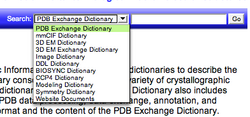
The search form available for data dictionaries at
http://mmcif.pdb.org. To search for a particular item,
select the dictionary you want to search
from the pulldown menu, enter the term
in the box provided, and select "go".
The PDB Exchange Dictionary uses the dictionary language developed for the macromolecular Crystallographic Information File (mmCIF) dictionary (2). The dictionary includes textual definitions and examples as would be found in any language dictionary, as well as data type, boundary conditions and controlled vocabularies that can be used by software applications to validate and maintain uniformity of usage in data files. Since the dictionary is fully software accessible it can also be translated into alternative formats, as has been done in the case of the eXtensible Markup Language (XML) to provide a PDBML dictionary.(3)
Questions and comments should be sent to info@rcsb.org.
- Westbrook, J., Henrick, K., Ulrich, E.L. and Berman, H.M. (2005) In Hall, S. R. and McMahon, B. (eds.), International Tables for Crystallography. Springer, Dordrecht, The Netherlands, Vol. G. Definition and exchange of crystallographic data, pp. 195-198.
- Fitzgerald, P.M.D., Westbrook, J.D., Bourne, P.E., McMahon, B., Watenpaugh, K.D. and Berman, H.M. (2005) In Hall, S. R. and McMahon, B. (eds.), International Tables for Crystallography. Springer, Dordrecht, The Netherlands, Vol. G. Definition and exchange of crystallographic data, pp. 295-443.
- Westbrook, J., Ito, N., Nakamura, H., Henrick, K. and Berman, H.M. (2005) PDBML: The representation of archival macromolecular structure data in XML. Bioinformatics, 21, 988-992.
05-September-2006
Next Generation of ADIT Available for Depositions and Testing
When depositing your next structure, try using beta-ADIT. It has been designed to make your deposited entries more complete and error-free. Beta-ADIT offers a number of advantages over the current version of ADIT, including:
- Consistency checking between sequence and coordinates
- Indication of format errors, with suggestions for solutions
- Easier options for entering author information
Structures deposited using beta-ADIT will result in real deposition sessions that will be processed by annotators.
beta-ADIT will become the only version of ADIT after a period of testing. Please help us improve this tool by sending your feedback to deposit@deposit.rcsb.org.
29-August-2006
New RCSB PDB Flyers Available in Print and Online
Two new brochures are available for RCSB PDB users.
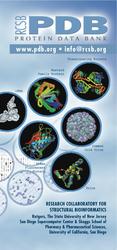
The General Information trifold provides an overview of the RCSB PDB project, and includes information about data deposition, data query and reporting, Molecule of the Month, structural genomics, wwPDB, and outreach and education resources.
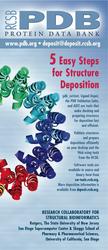
5 Easy Steps for Structure Deposition describes the tools that facilitate NMR and X-ray crystal structure deposition and validation for use by the authors of the structures.
To receive printed copies of these flyers, please send your postal address and brochure request to info@rcsb.org. Requests can be made for multiple copies.
22-August-2006
RCSB PDB Poster Prize Awarded at ACA and ECM Meetings
Thanks to everyone who participated in the recent RCSB PDB Poster Prize competitions for best student poster related to macromolecular crystallography.
ACA
 The award at the American Crystallographic Association's Annual Meeting (July 22-27; Honolulu, Hawaii) was a tie:
The award at the American Crystallographic Association's Annual Meeting (July 22-27; Honolulu, Hawaii) was a tie:
Thioesterase domain of human fatty acid synthase: structural insights into chain-length selectivity.
Charles W. Pemble (1), Steve J. Kridel(2), Todd T. Lowther(1)
(1) Department of Biochemistry, (2) Department of Cancer Biology, School of Medicine, Wake Forest University, Winston-Salem, NC
 Structure of Adeno-Associated Virus 1 to 8.6 Angstrom Resolution by Cryo-Electron Microscopy.
Structure of Adeno-Associated Virus 1 to 8.6 Angstrom Resolution by Cryo-Electron Microscopy.
Edward Miller (1), Brittney Gurda-Whitaker (1), Lakshmanan Govindasamy (1), Xiaodong Yan (2), Robert McKenna (1), Sergei Zolotukhin (3), Nicholas Muzyczka (4), Timothy Baker (2), Mavis Agbandje-McKenna (1)
(1) Department of Biochemistry & Molecular Biology, (3) Department of Pediatrics, (4) Department of Molecular Genetics & Microbiology, COM, University of Florida, FL; (2) Department of Chemistry/Biochemistry & Molecular Biology, UCSD, San Diego, CA
Judges: Marc Allaire (Brookhaven National Laboratory), John Badger (ActiveSight), Zygmunt Derewenda - Chair (University of Virginia), Quan Hao (Cornell University), Mariusz Jaskolski (A Mickiewicz University), and Charles Weeks (Hauptman-Woodward MRI)
Organizer: Zongchao Jia (Queen's University)
ECM
At the European Crystallographic Meeting (August 6- 11, Leuven, Belgium), the award went to:
 SdsA1 from P. aeruginosa, defines a new mechanistic class of sulfatases
SdsA1 from P. aeruginosa, defines a new mechanistic class of sulfatases
Gregor Hagelüken (1), Thorsten M. Adams (2,3), Lutz Wiehlmann (3), Ute Widow (1), Harald Kolmar (2,4), Burkhard Tümmler (3), Dirk W. Heinz (1), Wolf-Dieter Schubert (1)
(1) Helmholtz Centre for Infection Research, formerly German Research Centre for Biotechnology, (2) University of Göttingen, (3) Medizinische Hochschule Hannover, and (4) Darmstadt University of Technology
Judges: Bohdan Schneider (RCSB PDB and Academy of Sciences of the Czech Republic), Guy Dodson (University of York), Wolf-Dieter Schubert (German Research Centre for Biotechnology), Johann Wouters (University of Namur), Sergei Strelkov (Catholic University of Leuven)
Organizer: Bohdan Schneider
15-August-2006
Phasing Out Theoretical Model Depositions to the PDB Archive
Effective October 15, 2006, PDB depositions will be restricted to atomic coordinates that are substantially determined by experimental measurements on specimens containing biological macromolecules. This policy was recommended and endorsed by a working group comprised of structural and computational biologists and endorsed by the wwPDB advisory committee. Thus, theoretical model depositions (such as models determined purely in silico using, for example, homology or ab initio methods) will no longer be accepted.
Theoretical models that have been previously released or that will be released from now until October 15, 2006 will continue to be publicly available via the existing models archive at ftp://ftp.rcsb.org/pub/pdb/data/structures/models/current/.
A summary of the implementation plan for the phasing out of theoretical models is available in HTML and PDF formats. A paper describing the outcome of the Workshop on Archiving Structural Models of Biological Macromolecules will be available in the August 16 issue of Structure1.
Questions about this transition should be sent to info@wwpdb.org.
1.H.M. Berman, S.K. Burley, W. Chiu, A. Sali, A. Adzhubei, P.E. Bourne, S.H. Bryant, J. Roland L. Dunbrack, K. Fidelis, J. Frank, A. Godzik, K. Henrick, A. Joachimiak, B. Heymann, D. Jones, J.L. Markley, J. Moult, G.T. Montelione, C. Orengo, M.G. Rossmann, B. Rost, H. Saibil, T. Schwede, D.M. Standley, and J.D. Westbrook (2006) Outcome of a workshop on archiving structural models of biological macromolecules. Structure. 14: 1211-1217.
08-August-2006

RCSB PDB Newsletter Summer 2006
The latest RCSB PDB Newsletter has been published in HTML and PDF formats.
This issue of the newsletter describes new developments, including pdb_extract for NMR depositions, Web Services, scripts for downloading PDB data, and the RSS feed for new structures. In this quarter's Education Corner, Cheryl Campbell describes her path to the PDB, and Michael G. Rossmann discusses his scientific career in the Community Focus.
If you would like to receive a printed version of the RCSB PDB quarterly newsletter, please send your postal address to info@rcsb.org.
Subscription information for the plain text electronic version is also available.
01-August-2006

Upcoming Meetings: ECM, ISMB and Swiss-Prot 20
At the beginning of August, the RCSB PDB will be be at:
- 14th Annual International Conference on Intelligent Systems for Molecular Biology (ISMB; August 6 - 10, Fortaleza, Brazil).
Stop by booth #21 for detailed demonstrations of the RCSB PDB web site and software applications. In addition to a general introduction to the new web site, demonstrations will include everything from how to use new search tools to detailed tutorials on new visualization software. Visitors can also get a full demonstration and sample code for accessing data and resources through our web services framework. RCSB PDB Co-Director, Philip E. Bourne, who is also the program Chair for ISMB 2006, will be on hand with staff members Jeff Milton and Stella Veretnik to answer any questions about the RCSB PDB.
The best student poster in the Structural Bioinformatics category will also receive the RCSB PDB Poster Prize.
For more information on ISMB please visit:
http://ismb2006.cbi.cnptia.embrapa.br/index.html -
In Silico Analysis of Proteins - Celebrating the 20th Anniversary of
Swiss-Prot, July 30th - August 4th in Fortaleza, Brazil.
As part of the celebration of Swiss-Prot's 20 years of service to the scientific community, RCSB PDB Co-Director Philip E. Bourne will present a lecture "The RCSB PDB - Teaching an Old Dog New Tricks" on August 4 at 9:30am.
For more information on the meeting please visit http://www.swissprot20.org/ - 23rd European Crystallographic Meeting (ECM; August 6 - 11, Leuven, Belgium). The RCSB PDB Poster Prize will be awarded to the best student poster at this meeting. The poster will be selected by a committee chaired by annotator Bohdan Schneider.
We hope to see you at these meetings.
25-July-2006

Advanced Search Tutorial
The majority of simple searches of the RCSB PDB website are performed using the keyword box at the top of each page. More specific and complex searches are possible using the "Advanced Search" that appears at the top of each page. The Advanced Search fully unleashes the power of the RCSB PDB query engine.
The screen shot shows the advanced search page. The "Quick Feature Guide" on the right will bring up a tutorial on how to make an advanced search. This short animated and narrated tutorial requires Flash software. This is built into many browsers or may be downloaded free and installed as a plug-in (see http://www.adobe.com/go/getflashplayer).
At the conclusion of the tutorial, which describes the major features of advanced search, the listener has the option to go to a further advanced search help page for full details of using all the features of advanced search. If you have any problems using advanced search, email info@rcsb.org for help. Suggestions for improvements are always welcome.
25-July-2006
Art of Science Exhibit at CUNY
"The Art of Science" exhibit will be on display at City College, The City University of New York from August 1-11, 2006. Sponsored by the Pathways Bioinformatics and Biomolecular Center, Science Division, the show will be on display in the Aronow Theater Foyer from 10:00 a.m. to 5:00 p.m.
The exhibit will be opened with a presentation by Helen M. Berman, Director of the RCSB Protein Data Bank at noon on August 1. The exhibit and lecture is free and open to the public.
The Art of Science traveling exhibit includes pictures available from the RCSB PDB website and Molecule of the Month features. If you would be interested in sponsoring this exhibit at your institution, please let us know at info@rcsb.org.
18-July-2006
ACA's Annual Meeting: RCSB PDB Director To Receive Award, Exhibit Booth Demonstrations, And Poster Prize
The RCSB PDB will be actively involved with the Annual National Meeting of the American Crystallographic Association (ACA) July 22 to July 27, 2006 in Honolulu, Hawaii.
The Buerger Symposium to be held on Sunday, July 23 (1:30 - 5:30 p.m. in the Lanai Room) honors Buerger Award recipient Helen M. Berman (Board of Governors Professor at Rutgers, The State University of New Jersey and Director of the RCSB PDB). The award recognizes her lifetime work in the pioneering development of information services for the global community of researchers who both produce and use macromolecular structural data. The symposium will focus on new and emerging technologies for determining biological macromolecular structures, on how the resultant data is used to further the understanding of molecular function, and on the underpinnings of the bioinformatics framework that makes many of these studies possible.
The M.J. Buerger Award was established in 1983 and first awarded in 1985. The triennial award is given in memory of Martin J. Buerger, Institute Professor Emeritus of M.I.T. and University Professor Emeritus of the University of Connecticut, a mineralogist who made major contributions to many areas of crystallography. The award recognizes established scientists who have made contributions of exceptional distinction in areas of interest to the ACA.
The "Structural Biology from all Angles" symposium will be chaired by Judith L. Flippen-Anderson and will feature presentations from Helen Berman, Jordi Bella (University of Manchester), Stephen K. Burley (SGX Pharmaceuticals), Wah Chiu (Baylor College of Medicine), Paula Fitzgerald (Merck Research Laboratories), Stephen Neidle (University of London), and John Westbrook (Rutgers).
Also at this ACA meeting, the RCSB PDB will be offering:
Exhibit Booth and Demonstrations. RCSB PDB members will be on hand to answer your questions and provide demonstrations of deposition software in the exhibit hall (Booth #603).
RCSB PDB Poster Prize. The RCSB PDB Poster Prize will be awarded to the best student poster presentation at this year's meeting. Students indicated their interest in participating as part of their abstract submission. The award will consist of educational books. An announcement will appear on the website and newsletter. The RCSB PDB Poster Prize will also be awarded at the meetings of the other IUCr Regional Associates – the European Crystallographic Association and the Asian Crystallographic Association. At the Intelligent Systems for Molecular Biology (ISMB), the prize will be awarded to the best student poster in the "Structural Bioinformatics" category.
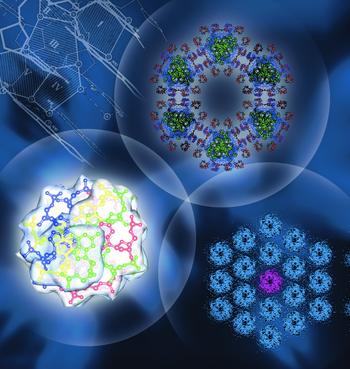 Some representatives images of structures done in the course of Helen Berman's research career (clockwise, starting from the upper left): hydration pattern around a dinucleoside phosphate-drug complex (described in (1)), crystal packing in a structure of a ternary complex among CAP, DNA and aCTD (2), crystal packing of a collagen peptide showing the extensive hydration (3), and a view down the helix axis of a B-DNA helix (4).
Some representatives images of structures done in the course of Helen Berman's research career (clockwise, starting from the upper left): hydration pattern around a dinucleoside phosphate-drug complex (described in (1)), crystal packing in a structure of a ternary complex among CAP, DNA and aCTD (2), crystal packing of a collagen peptide showing the extensive hydration (3), and a view down the helix axis of a B-DNA helix (4).
Image from the summer issue of ACA RefleXions.
1. Neidle, S., Berman, H. and Shieh, H.S. (1980) Highly structured water network in crystals of a deoxydinucleoside-drug complex. Nature, 288, 129-133.
2. Benoff, B., Yang, H., Lawson, C., Parkinson, G., Liu, J., Blatter, E., Ebright, Y.W., Berman, H.M. and Ebright, R.H. (2002) Structural basis of transcription activation: The CAP-alphaCTD-DNA complex. Science, 297, 1562-1566.
3. Bella, J., Brodsky, B. and Berman, H.M. (1995) Hydration structure of a collagen peptide. Structure, 3, 893-906.
4. Berman, H.M. (1997) Crystal studies of B-DNA: the answers and the questions. Biopolymers, 44, 23-44.
11-July-2006
Protein Workshop: A Visualization Tool
Protein Workshop is a new molecular viewer available from the RCSB PDB from every structure summary page. Its simple interface lets users quickly and easily select structural elements and change the coloring, labeling, and representation style (ribbons, cylinders, and more). Users can also color specific structural features based on conformation type, hydrophobicity, and residue type.
Protein Workshop is an excellent tool for generating high-resolution images in JPG, BMP, TIFF, WBMP, and PNG formats. A tutorial for creating these images is available.
This Java tool uses the Molecular Biology Toolkit (mbt) and JOGL technology, and requires no installation other than the most recent version of Java. A tutorial is provided to guide users in using the program.
Figures created using Protein Workshop should cite the RCSB PDB and the mbt.
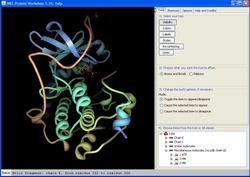 Protein kinase visualized using Protein Workshop. (1atp: Zheng J, Trafny EA, Knighton DR, Xuong NH, Taylor SS, Ten Eyck LF, Sowadski JM. 2.2 A refined crystal structure of the catalytic subunit of cAMP-dependent protein kinase complexed with MnATP and a peptide inhibitor. Acta Crystallogr D Biol Crystallogr. 1993 49:362-5.)
Protein kinase visualized using Protein Workshop. (1atp: Zheng J, Trafny EA, Knighton DR, Xuong NH, Taylor SS, Ten Eyck LF, Sowadski JM. 2.2 A refined crystal structure of the catalytic subunit of cAMP-dependent protein kinase complexed with MnATP and a peptide inhibitor. Acta Crystallogr D Biol Crystallogr. 1993 49:362-5.)
04-July-2006

RCSB PDB Focus: Tips for Depositing Multiple Related Structures using ADIT
When depositing many structures that are related to one another, there are a few ways of making the ADIT process simpler:
- Structures solved using X-ray crystallography or NMR should be prepared using pdb_extract before using ADIT. This will minimize manual typing and save time during the deposition process. pdb_extract takes information about data collection, phasing, density modification, and the final structure refinement from the output files and log files produced by the various applications used for structure determination. The collected information is organized into a file ready for deposition using ADIT. Information duplicated in all entries (author name, citation information, protein names, etc.) can be included in a text file that is prepared once and used for running pdb_extract for each entry. After pdb_extract has combined all the available information into a single file for each structure, ADIT can be used for quick deposition.
- A similar tool is being developed for structures solved by other experimental methods. For these structures, deposit one representative structure following the instructions provided at deposit.pdb.org. Then write to deposit@deposit.rcsb.org to let us know about the other related entries. Once the first entry has been annotated, processed and finalized, it can be used as a template for your subsequent depositions. For each structure, replace the coordinates and update the information in the header section of the PDB file as necessary to prepare the related files for deposition.
- If the structures have ligands, drugs or inhibitors bound to them, please check Ligand Depot and match the 3 letter code in the file to the one used in the chemical component dictionary. If the ligand is not present in the dictionary, please email detailed information (complete chemical name, 2D figure showing connectivity, bond order and sterochemistry) along with the RCSB and PDB IDs of the entries they are associated to expedite the processing of these files.
27-June-2006
RCSB PDB Focus: Using Images From the RCSB PDB
The contents of the RCSB PDB are in the public domain. Online and printed resources are welcome to include PDB data and images from the RCSB PDB pages as long as the images are not being sold commercially. It is expected that the corresponding citations are included.
 For example, the prepared images available for each structure (from the Structure Explorer pages) should cite the corresponding reference for the entry and the RCSB PDB:
For example, the prepared images available for each structure (from the Structure Explorer pages) should cite the corresponding reference for the entry and the RCSB PDB:
PDB ID: 1di0 B.C.Braden, C.A.Velikovsky, A.A.Cauerhff, I.Polikarpov, F.A.Goldbaum, Divergence in Macromolecular Assembly: X-Ray Crystallographic Structure Analysis of Lumazine Synthase from Brucella abortus, J.Mol.Biol. 297 pp. 1031 (2000). Image from the RCSB PDB (www.pdb.org; H.M.Berman, J.Westbrook, Z.Feng, G.Gilliland, T.N.Bhat, H.Weissig, I.N.Shindyalov, P.E.Bourne, The Protein Data Bank, Nucleic Acids Research, 28 pp. 235-242 (2000))
![]() Pictures from Molecule of the Month features should also credit the illustrator David S. Goodsell of the Scripps Research Institute:
Pictures from Molecule of the Month features should also credit the illustrator David S. Goodsell of the Scripps Research Institute:
Image of luciferase from David S. Goodsell's (The Scripps Research Institute) Molecule of the Month series at the RCSB PDB (www.pdb.org; H.M.Berman, J.Westbrook, Z.Feng, G.Gilliland, T.N.Bhat, H.Weissig, I.N.Shindyalov, P.E.Bourne, The Protein Data Bank, Nucleic Acids Research, 28 pp. 235-242 (2000); structure shown is 2d1s: T.Nakatsu, S.Ichiyama, J.Hiratake, A.Saldanha, N.Kobashi, K.Sakata, H.Kato, Structural basis for the spectral difference in luciferase bioluminescence, Nature, 440 pp.372-376 (2006))
A full list of related citations is available online.
20-June-2006

PDB Archive Focus: Worldwide Data Annotation
Data from X-ray crystallographic, NMR, and cryo-electron microscopic experiments are deposited to the PDB archive by scientists from all over the world.
PDB data are processed by an international effort involving members of the wwPDB – the RCSB PDB, the Macromolecular Structure Database at the EMBL's European Bioinformatics Institute, and Protein Data Bank Japan. wwPDB annotators work with these data to make sure they are represented in the PDB archive in the best way possible. They run a series of checks, make corrections, and correspond with the depositors in an effort to make the data public as quickly and accurately as possible.
Statistics about the number of structures deposited, processed, and released by the wwPDB are available at http://www.wwpdb.org/stats.html
13-June-2006
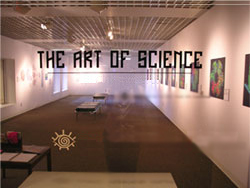
The Art of Science Exhibit as it was displayed
last year at Texas A&M University.
Art of Science Exhibit at UCSD
Featuring images that explore the beauty found in structural biology, the RCSB PDB's Art of Science exhibit will be on display with other artworks at CalIT2 (University of California, San Diego) from June 9 – 30, 2006.
Molecule of the Month writer and illustrator David S. Goodsell (The Scripps Research Institute) has also provided additional watercolors, including a cross-section of blood serum, the interaction of HIV in the blood, and an illustration of a eukaryotic cytoplasm.
A wood carving of anthocyanidin synthatase, the natural pigment of berries, fruits and grapes, and a sculpture of human metalloelastase – both by Edgar Meyer (Texas A&M) – are also on display.
The exhibit is located in the "pre-function" area of the CalIT2 building on the UCSD campus and is accessible from 9-5 p.m. weekdays. It is next to the virtual reality visualization lab where "PDB-in-a-CAVE" can be run. The CAVE offers a room-sized space for users to interact with high-resolution video. Wearing stereoglasses, the viewer can move through and around a projected biological macromolecule. Please contact info@rcsb.org if you would like to schedule a trip to the CAVE while you are visiting the Art of Science.
The Art of Science traveling exhibit includes pictures available from the RCSB PDB website and Molecule of the Month features. Since its beginnings at Rutgers University in New Jersey, the show has traveled to EMBL-Hamburg, Germany; University of Wisconsin-Madison; California State University, Fullerton; Purdue University; and Hyderabad, India. The RCSB PDB would like to see the Art of Science travel to other places. If you would be interested in sponsoring this exhibit at your institution, please let us know at info@rcsb.org.
06-June-2006

pdb_extract Now Supports NMR Depositions
The program pdb_extract1, which has simplified the deposition of crystal structures, can now be used for NMR depositions. The latest version supports NMR-related information from the applications X-Plor/CNS/CNX, CYANA, and DYANA. Other enhancements made to the pdb_extract suite are detailed in the Version Release Notes.
pdb_extract minimizes errors and saves time during the deposition process since fewer data items have to be manually entered.
The program extracts key details from the output files produced by many X-ray crystallographic and NMR applications for use in the deposition process. The program merges these data into macromolecular Crystallographic Information File (mmCIF) data files that can be used with ADIT to perform validation and to add any additional information for PDB deposition.
pdb_extract can be used via web interface or downloadable workstation from pdb-extract.rcsb.org.
1. Automated and accurate deposition of structures solved by X-ray diffraction to the Protein Data Bank. (2004) Acta Cryst. D60, pp. 1833-1839.
30-May-2006
RCSB PDB Offers Web Services
The RCSB PDB has introduced Web Services to help the software developer community build tools that interact more effectively with PDB data. Instead of storing coordinate files and related data locally, web services provide a way for software tools to interact with the RCSB PDB remotely.
The RCSB PDB's web services were implemented using Axis and include BLAST, FASTA, PubMed, and SNP queries. A complete list of web services and their WSDL description (Web Services Description Language in XML Format) are available.
Web services allow the developer community to build applications that are platform independent and require only a traditional HTTP connection. This is especially useful for developing in environments with relatively tight security constraints. Web services also provide a low-overhead approach to designing workflow applications that integrate remote services. Developers can write efficient and manageable distributed tools without having to worry about low-level communication details. Using web services, programmers can write efficient workflow tools. For example, a developer could write a tool that interoperates between local data, PDB data, and NCBI data.
For general information on web services, please visit http://www.w3.org/2002/ws/.
23-May-2006
Automated Downloads of PDB Data
The RCSB PDB FTP site provides coordinate data (in PDB, mmCIF, and PDBML/XML formats) and experimental data. A web interface offers a way to download multiple data files from the archive. Scripts are also available to assist in the automated download of data from the ftp site:
ftp://snapshots.rcsb.org/rsyncSnapshots.sh
Makes a local copy of an annual snapshot or sections of the snapshot.
This script is annotated to assist in downloading only sections of
the archive. The time required to download the entire archive
can be lengthy (18+ hours); however, the time required to
download the coordinate data in a single format should be much
less. While the amount of time depends upon network speed, our
tests show that all of the coordinate files in PDB format from a
snapshot can be downloaded in about 2 1/2 hours.
ftp://ftp.rcsb.org/pub/pdb/software/rsyncPDB.sh
Copies the current contents of the entire archive.
ftp://ftp.rcsb.org/pub/pdb/software/getPdbStructures.pl
Copies portions of the archive.
ftp://ftp.rcsb.org/pub/pdb/software/getPdbUpdate.pl
Copies the data from the weekly updates.
Questions and comments about these scripts should be sent to info@rcsb.org.
16-May-2006

BioSync is Alive and Growing
BioSync (Structural Biology Synchrotron Users Organization) was formed in 1990 as a grassroots organization intended to promote access to synchrotron radiation. It established a web-based clearinghouse for beamline information at synchrotron facilities. The BioSync resource, originally designed and hosted by UCSD/SDSC, has been updated and is now being maintained by the RCSB PDB.
With its bright new look, the BioSync website currently contains updated descriptions of operational US synchrotron beamlines used for single crystal macromolecular crystallography. International sites and beamlines are listed and will go 'live' as data is added for each one. PDB deposition statistics, grouped by site and beamline, are also available.
Future plans for the BioSync site include adding more beamlines for small angle X-ray scattering, X-ray spectroscopy and neutron scattering, and cross linking with the RCSB PDB.
Comments and suggestions are welcome at biosync@deposit.rcsb.org.
09-May-2006

RCSB PDB Poster Prize at ACA, ECM, ISMB, and AsCA
The RCSB PDB is pleased to announce the 2006 RCSB PDB Poster Prize, which recognizes student poster presentations at society meetings.
The prize will be awarded to the best posters related to macromolecular crystallography by undergraduate or graduate students at each of the meetings of the IUCr Regional Associates–the American Crystallographic Association (ACA), the European Crystallographic Association (ECM), and the Asian Crystallographic Association (AsCA).
At the Intelligent Systems for Molecular Biology (ISMB), the prize will be awarded to the best student poster in the "Structural Bioinformatics" category.
The awards consist of related educational books, and will be announced through the RCSB PDB website and newsletter. Information about previous winners and awards is available (2003, 2004, 2005).
02-May-2006
RSS Functionality at the RCSB PDB
 An RSS (Really Simple Syndication) feed provides users with a list of newly updated structures as soon as they are available. RSS pushes information that can be read by client software (an RSS reader) that sits on your local computer. Rather than going to look for new PDB entries, they can come to you.
An RSS (Really Simple Syndication) feed provides users with a list of newly updated structures as soon as they are available. RSS pushes information that can be read by client software (an RSS reader) that sits on your local computer. Rather than going to look for new PDB entries, they can come to you.
To start, download and install an RSS reader. Depending on your reader, either drag or click on the orange RSS icon from the top of the RCSB PDB home page (located just next to the latest release date) to add the URL for new structures to your RSS reader.
You will now be informed of new structures as they become available. Clicking on the update notice will take you to the list of new structures.
Some examples of RSS readers include:
- Google desktop
- Firefox extensions called RSS Wiz or RSS Ticker
- For OSX, you can just use Safari
- NetNewsWire
- IE7 Beta
- Firefox built in "Live Bookmarks"
- Vienna
For more information on RSS see the following:
- RSS-tutorial for webmasters
- Understanding and implementing RSS Content Feeds and Syndication
- Google RSS Readers
25-April-2006
RCSB PDB Newsletter Spring 2006
Articles About Searching the New Site, High School Protein Modeling Events, and more. Community Focus Interview with Shri C. Jain (RCSB PDB) and an Education Corner look at Making Virus Structures with Middle School Students
The latest RCSB PDB Newsletter has been published in HTML and PDF formats. Article highlights include a description of how validating structures saves overall deposition time, and a look at the online table of structures solved by multiple techniques.
This quarter's Education Corner describes how the RCSB PDB was able to guide middle school students in making handheld models of the common cold. Also in this issue, Shri C. Jain describes looks at his scientific career, from determining structures to training annotators at the RCSB PDB.
If you would like to receive a printed version of the RCSB PDB quarterly newsletter, please send your postal address to info@rcsb.org.
Subscription information for the plain text electronic version is also available.
18-April-2006

Education Focus: DNA Day
"National DNA Day" will be celebrated again on April 25. Commemorating the completion of the Human Genome Project in April 2003 and the discovery of DNA's double helix, DNA Day encourages teachers and students to celebrate these historic achievements. Online resources relating to DNA Day include the following:
- The National Human Genome Research Institute will be sponsoring an online webcast and chatroom on DNA Day, in addition to providing a variety of teaching materials.
- The Nucleic Acid Database is a repository of three-dimensional structural information about nucleic acids. The NDB has a searchable database and a browsable Atlas that provides summary information and images for each structure in the database.
- The PDB has many education resources related to nucleic acid structure, including Molecule of the Month features on DNA, Transfer RNA, and Self-splicing RNA.
- The Nature Publishing Group has compiled the original articles, historical perspectives, and examinations of DNA in medicine, society, and as a biological molecule in "Double Helix: 50 years of DNA".
- BBC News has compiled resources and images describing the story behind the discovery at http://news.bbc.co.uk/1/hi/in_depth/sci_tech/2003/dna_at_50/default.stm
11-April-2006
Validating Structures Saves Deposition Time
To lower the number of revisions and problems found during the annotation process, depositors should validate their structure, provide the correct and complete sequence, and run BLAST[1].
The Validation Server allows the user to check the format of coordinate and structure factor files, and to create a variety of validation reports about a structure. When the validation process is complete, users are presented with a validation report which includes an Atlas entry, a summary report, and a collection of structural diagnostics including bond distance and angle comparisons, torsion angle comparisons, base morphology comparisons (for nucleic acids), and an image of the molecule. Reports from MolProbity [2], PROCHECK [3], NUCheck, and SFCheck [4] are made available. Validating a structure using this tool helps authors spot possible errors in the structure prior to starting a deposition session.
Structures can also be validated using ADIT by selecting the 'validate' option before proceeding to 'deposit' option.
It is also important to provide the complete and correct sequence for polymers. The deposited sequence should include all residues in the crystal or NMR tube used for the experiment, including uncleaved His tags and cloning artifacts and any residues missing from the coordinates due to lack of electron density or disorder. The one letter code sequence should not conflict with the sequence from the coordinates.
Annotators perform a BLAST to find a match for the deposited sequence with a sequence database reference. Based on these search results, sequence database records are generated in the PDB entry. If the deposited sequence is in conflict with the known database sequence, records are created in the entry with the proper explanation of the conflict. Running BLAST on the sequence prior to deposition can help authors find possible mismatches. If the polymer has engineered mutations they should be mentioned in the "Molecule Details, Specific mutation" section of ADIT for proper annotation.
Providing the correct and complete sequence, running a BLAST search and validating the structure help make the annotation process fast and easy as well as each PDB entry complete and accurate.
- Wheeler, D.L., Barrett, T., Benson, D.A., Bryant, S.H., Canese, K., Church, D.M., DiCuccio, M., Edgar, R., Federhen, S., Helmberg, W., Kenton, D.L., Khovayko, O., Lipman, D.J., Madden, T.L., Maglott, D.R., Ostell, J., Pontius, J.U., Pruitt, K.D., Schuler, G.D., Schriml, L.M., Sequeira, E., Sherry, S.T., Sirotkin, K., Starchenko, G., Suzek, T.O., Tatusov, R., Tatusova, T.A., Wagner, L., and Yaschenko, E. (2005). Database resources of the National Center for Biotechnology Information. Nucleic Acids Res 33, D39-45.
- Davis, I.W., Murray, L.W., Richardson, J.S., and Richardson, D.C. (2004). MOLPROBITY: structure validation and all-atom contact analysis for nucleic acids and their complexes. Nucleic Acids Res 32, W615-619.
- Laskowski, R.A., Rullmann, J.A., MacArthur, M.W., Kaptein, R., and Thornton, J.M. (1996). AQUA and PROCHECK-NMR: programs for checking the quality of protein structures solved by NMR. J. Biomol. NMR 8, 477-486.
- Vaguine, A.A., Richelle, J., and Wodak, S.J. (1999). SFCHECK: a unified set of procedures for evaluating the quality of macromolecular structure-factor data and their agreement with the atomic model. Acta Crystallogr D Biol Crystallogr 55, 191-205.
04-April-2006
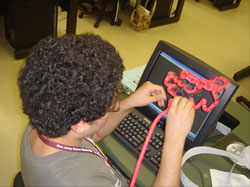
East Brunswick High School Places First in the NJ Science Olympiad Protein Modeling State Competition
Several high school teams competed in the protein modeling trial event at the New Jersey State Science Olympiad held March 14, 2006 at Middlesex County College.
At the start of the olympiad, the student teams submitted a previously prepared model and written description of the TATA-binding protein they created using resources available from the RCSB PDB. Then, armed with the Molecule of the Month feature, the PDB coordinate file, and the structure's primary citation to complete the challenge, each team built a three-dimensional protein model of a cholera toxin and answered written questions about the structure, function, importance, and history of the protein.
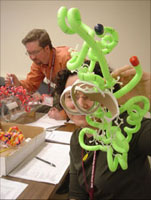
The three-dimensional protein models are built using Mini-Toober kits provided by the RCSB PDB.

In an extremely close competition, East Brunswick High School (First Place), The Lawrenceville School (Second Place), and Montgomery High School (Third Place) created very strong models.
Special thanks to our judges from the RCSB PDB (Kyle Burkhardt, Jeramia Ory, Irina Persikova, Massy Rajabzadeh, Monica Sundd, and Jasmine Young), the NJ Science Olympiad organizers, and to the MSOE Center for BioMolecular Modeling for the design of this event.
Questions about the NJ Science Olympiad Protein Modeling trial event should be sent to buildmodels@deposit.rcsb.org.
28-March-2006
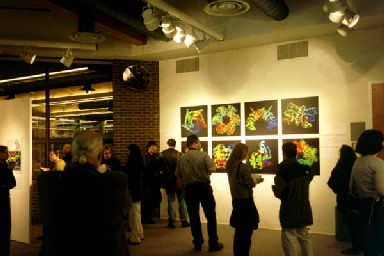
Art of Science Exhibit and "PDB-in-a-Cave" at Virginia Tech Structural Biology Symposium
Images from the RCSB PDB's "Art of Science" exhibit will be on display at Virginia Polytechnic Institute and State University as part of their Structural Biology Symposium (March 31 - April 1, Blacksburg, VA).
Attendees will also be able to explore protein structures in the "PDB-in-a-CAVE" environment. The CAVE offers a room-sized space for users to interact with high-resolution video. Wearing stereoglasses, the viewer can move through and around a structure that is projected in the CAVE.
The Art of Science traveling exhibit displays images of molecules in the PDB, including the pictures available from Structure Explorer pages and from Molecule of the Month features. Since its beginnings at a space dedicated to art exhibits at Rutgers University, the show has travelled to EMBL-Hamburg, Germany; University of Wisconsin- Madison; California State University, Fullerton; Purdue University; and Hyderabad, India. The RCSB PDB would like to see the "Art of Science" travel to other places. If you would be interested in sponsoring this exhibit at your institution, please let us know at info@rcsb.org.
21-March-2006

RCSB PDB Exhibit Booth and Presentations at Experimental Biology
The RCSB PDB be will participating in the American Society for Biochemistry and Molecular Biology's (ASBMB) Annual Meeting (April 1-5, San Francisco, CA), which is being held in conjunction with the Experimental Biology conference.
Demonstrations will be available at booth #317 during the exhibition.
Shuchismita Dutta will be presenting "Educational Resources for Structural Biology at the RCSB Protein Data Bank" as part of the poster presentations on Monday, April 3 (#A406) and as part of the "Outreach and Public Education" oral presentations on Tuesday, April 4.
In addition to ASBMB, the other sponsoring societies of this meeting are the American Association of Anatomists, American Physiological Society, American Society for Investigative Pathology, American Society for Nutrition, Inc., and the American Society for Pharmacology and Experimental Therapeutics.
14-March-2006
RCSB PDB at Science Expo for NJ Students
On March 21, the RCSB PDB will take part in a Science Expo held at Princeton University for middle school students from New Jersey. The RCSB PDB's "Exploration Station" will offer demonstrations of the RCSB PDB website and hands-on protein modeling activities. The event is part of Princeton's Molecular Biology Outreach Program.
07-March-2006
RCSB PDB Focus: Frequently Asked Questions
The Frequently Asked Questions page answers a number of common queries about the new RCSB PDB site, including How do I link to a Structure Summary page for a PDB ID? and What are the URLs to download files?.
Questions related to searching, reporting, and using all of the resources available from the RCSB PDB not found on this page should be sent to info@rcsb.org.
For deposition-related queries, please see the Deposition FAQ or contact us at deposit@deposit.rcsb.org.
28-February-2006
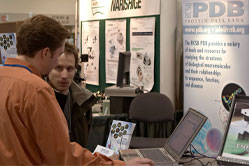
RCSB PDB Exhibit News
Thanks to everyone who stopped by the RCSB PDB exhibit booth at the 50th Annual Meeting of the Biophysical Society (February 18-22, 2005 in Salt Lake City, Utah). Wolfgang Bluhm and Jeramia Ory were on-hand to talk to users and to provide demonstrations of the new site.
The next RCSB PDB exhibit booth will be at the Experimental Biology (EB) meeting April 1-5 in San Francisco, CA. Shuchismita Dutta will also present a poster and talk on the subject of "Educational Resources for Structural Biology at the RCSB Protein Data Bank" at this meeting.
EB is sponsored by the American Association of Anatomists (AAA), American Physiological Society (APS), American Society for Biochemistry and Molecular Biology (ASBMB), American Society for Investigative Pathology (ASIP), American Society for Nutrition, Inc. (ASN), and American Society for Pharmacology and Experimental Therapeutics (ASPET).
21-February-2006
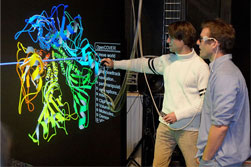
Virtual Reality Environment Highlights PDB Structures
To offer a new way of looking at molecular structure, the RCSB PDB and CalIT2 have released the first version of CAVE (Cave Automatic Virtual Environment) software for visualizing 3D macromolecular structures in an immersive, virtual reality environment. The CAVE offers a room-sized space for users to interact with high-resolution video. Wearing stereoglasses, the viewer can move through and around a structure that is projected in the CAVE.
The new software has an interface that makes a connection to the RCSB PDB web site to download and display files. In addition, the software also supports visualization of structure motions by supporting multiple file loading. For example, users may visualize structure motions from the Database of Molecular Movements.
With over 100 CAVE environments around the world, users may now download and visualize any PDB structure while in this unique environment.
The software, built on the COVISE platform, runs in the CAVE in both single user and collaborative modes. For more information about visualizing PDB structures in this virtual reality environment, please contact info@rcsb.org.
14-February-2006
PDB Statistics: Structures Solved by Multiple Methods
The content of the PDB archives can be examined in a variety of ways, including molecule type, resolution distribution, and journals cited. As the PDB archives grow larger, there is an overlap of data generated by different experimental methods. The RCSB PDB provides a statistics table to highlight structures solved by multiple techniques.
This list of proteins solved by multiple experimental methods was generated by clustering PDB protein chains of at least 100 amino acids into clusters of greater than 95% sequence similarity, and then listing only those clusters which contain at least one structure solved by one method (e.g. X-ray) and at least one structure solved by a different method (e.g. NMR). The clustering was done using CD-HIT.
Most of the statistics tables are created dynamically to access the most current PDB data.
07-February-2006
RCSB PDB Exhibit at the Biophysical Society Meeting
The RCSB PDB will participate in the exhibition at the 50th Annual Meeting of the Biophysical Society (February 18-22, 2005 in Salt Lake City, Utah). Staff will be available at booth #822 to answer questions and to demonstrate the features of the new web site. We hope to see you there!
31-January-2006

RCSB PDB Newsletter Winter 2006: Articles About Searching the New Site, Educational Workshops, and more. Community Focus Interview with Frank Allen (CCDC) and and Education Corner by Margaret A. Franzen, Pellissippi State Technical Community College
The latest RCSB PDB Newsletter has been published in HTML and PDF formats. Highlights include statistics about all structures deposited in 2005 and tips for users depositing data for the first time. Also described are resources for using the new site and recent education projects. In this quarter's Education Corner, Margaret A. Franzen looks at her involvement with a genetics course, independent study projects, and insecticide resistance activity. Also in this issue, Frank Allen discusses the Cambridge Crystallographic Data Centre in the Community Focus.
If you would like to receive a printed version of the RCSB PDB quarterly newsletter, please send your postal address to info@rcsb.org.
Subscription information for the plain text electronic version is also available.
24-January-2006
Montville Township High School Places First at the NJ Science Olympiad Protein Modeling Trial Event
Several high school teams competed in the protein modeling event at the New Jersey Northern Regional Science Olympiad that was held January 12, 2006 at Montclair State University.
At the start of the olympiad, the student teams submitted a previously prepared model and written description of the TATA-Binding Protein they created using resources available from the RCSB PDB. Then, each team built a model of PDB entry 1PSV and answered written questions about the structure, function, importance, and history of the protein. In a hushed room, the teams used the Molecule of the Month feature on Designer Proteins, the PDB coordinate file, and the structure's primary citation to complete the challenge.
The three-dimensional protein models are built using Mini-Toober kits provided by the RCSB PDB.
The students all submitted great structures, with awards going to Montville Township High School (First Place), Freehold High School (Second Place), and Alghazly High School (Third Place).
Special thanks to our judges from the RCSB PDB (Kyle Burkhardt, Cathy Lawson, Jeramia Ory, Irina Persikova, Massy Rajabzadeh, Monica Sundd, and Jasmine Young), the NJ Science Olympiad organizers, and to the MSOE Center for BioMolecular Modeling for the design of this event. We look forward to the NJ State Science Olympiad on March 12, where protein modeling will once again be a trial event.
Questions about the NJ Science Olympiad Protein Modeling trial event should be sent to buildmodels@deposit.rcsb.org.
17-January-2006
Time-stamped Copies of PDB Archive Available via FTP
Time-stamped yearly snapshots of the PDB Archive are available from ftp://snapshots.rcsb.org/. It is hoped that these snapshots will provide readily identifiable data sets for research on the PDB archive.
The directory 20060103, which contains the exact and complete contents of the FTP archive as it appeared on January 3, 2006, has been added. It includes the 34,421 experimentally-determined coordinate files that were current (i.e. not obsolete) as of January 3, 2006. It joins the directory 20050106, which contains the frozen content of the FTP archive as of January 6, 2005.
These snapshots follow the historical directory structure -- coordinate files are contained in subdirectories named after the two middle characters of the PDB ID, for example, 100d is found in the directory '00'.
In addition, symbolic links lead directly to the sets of experimentally determined coordinate files in PDB, mmCIF, and XML format, e.g. all_pdb_files_20060103, all_mmcif_files_20060103, and all_xml_files_20060103.
The date and time stamp of each file indicates the last time the file was modified. Entries in the PDB archive have been processed by the three members of the wwPDB (RCSB, MSD-EBI, and PDBj).
10-January-2006
Structural Genomics Tools and Portal Described in Nucleic Acids Research Database Issue
"The RCSB PDB information portal for structural genomics" has been published in the latest issue of Nucleic Acids Research.
The article describes the online tools, summary reports, and target information related to structural genomics from a new information portal at sg.pdb.org.
From this site, information and links are provided for the structural genomics initiatives located worldwide, including reports for each center that provide target lists, target status progress, targets in the PDB, and sequence redundancy analyses.
Databases that track the progress of protein studies are available. TargetDB contains information about the progress of the production and solution of structures. PepcDB extends the content of TargetDB with status history, stop conditions, reusable text protocols and contact information collected from the PSI Centers.
A tool is also provided to explore the distributions of functions found among structural genomics structures, PDB structures, genomes, and homology models. This functional coverage can be examined according to Enzyme Classification, Gene Ontology (Biological Process, Cell Component, or Molecular Function) and Disease.
The abstract and full text of the article are also available from the Nucleic Acids Research Web site.
Andrei Kouranov, Lei Xie, Joanna de la Cruz, Li Chen, John Westbrook, Philip E. Bourne and Helen M. Berman
The RCSB PDB information portal for structural genomics
Nucleic Acids Research, 2006, Vol. 34, Database issue D302-D305
03-January-2006
New RCSB PDB Website Provides Tools and Resources for Studying Biological Macromolecules
To provide a powerful portal for studying the structures of biological macromolecules and their relationships to sequence, function, and disease, the RCSB has enhanced and revised the RCSB website and database at www.pdb.org. The legacy FTP structure will continue to be supported at ftp://ftp.rcsb.org.
The RCSB PDB thanks everyone who has contributed to the development of this new resource since testing began in July 2004. Questions about the transition to this site not addressed in the FAQ should be sent to info@rcsb.org.
The new database utilizes PDB data that has been remediated and standardized for better searches and reports. Other features include improved ligand searching, a clear distinction between the reported primary and derived data, and the integration of external data resources (such as SCOP, CATH and chromosome location). A permanent search tab offers different ways of accessing the database, including a new method for "browsing" through structures grouped in categories (related to, for example, disease, molecular function, biochemical process, or cellular location).
Navigation of the website has been enhanced to keep the resources and tools related to structural genomics, education, and software within easy reach. A searchable help system with a glossary and user guide provides detailed information for accessing the website, database, and for understanding PDB data. A narrated presentation (in Flash) guides users through searching, navigating, generating reports, visualizing structures, and browsing PDB data on the new site. The structural genomics portal is enriched with target summary reports for centers worldwide, databases that track the progress of protein studies (TargetDB and PepcDB), and a tool to explore the distributions of functions found among structural genomics structures, PDB structures, genomes, and homology models.
- RCSB PDB Portal: http://www.pdb.org
- Legacy FTP Site: ftp.rcsb.org
- Tutorial
- PDB FAQ







